Kittredge Cherry's Blog: Q Spirit, page 60
February 12, 2013
Brothers by affection: Saints Polyeuct and Nearchus

Saints Polyeuct and Nearchus
By Brother Robert Lentz, OFM. © 1995, trinitystores.com
Saints Polyeuct and Nearchus were Roman soldiers in 3rd-century Armenia and “brothers by affection.” They are a prime example of same-sex lovers in the early church. Polyeuct’s feast day is Feb. 13.
The earliest account of Polyeuct’s martyrdom, a 4th-century Armenian biography, says that they were “brothers, not by birth, but by affection” and enjoyed “the closest possible relationship, being both comrades and fellow soldiers.”
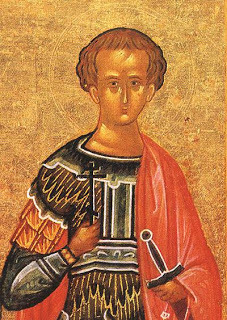
St. Polyeuctus (Wikimedia Commons)
Nearchus was Christian, but Polyeuct was not. The men had a strong desire to spend eternity together, so Polyeuct converted from paganism to Christianity, the faith of his beloved Nearchus. With a convert’s zeal he attacked a pagan procession. He was beheaded for his crime in the year 259 in the western Armenian city of Militene. Shortly before he was executed, he spoke his last words to Nearchus: “Remember our secret vow.” Thus Polyeuct is known as a protector of vows and avenger of broken promises, in addition to his role as a probable “gay saint.”
Yale history professor John Boswell names Polyeuct and Nearchus as one of the three primary pairs of same-sex lovers in the early church. (The others are Perpetua and Felicity and Sergius and Bacchus.) The love story of Polyeuct and Nearchus is told with extensive historical detail in two books, “Same Sex Unions in Pre-Modern Europe
 ” by Boswell and “Passionate Holiness
” by Boswell and “Passionate Holiness ” by Dennis O’Neill. He is founder of the Living Circle, the interfaith LGBT spirituality center that commissioned the above icon of the loving same-sex pair.
” by Dennis O’Neill. He is founder of the Living Circle, the interfaith LGBT spirituality center that commissioned the above icon of the loving same-sex pair.The icon is by Brother Robert Lentz, a Franciscan friar and world-class iconographer known for his innovative icons. It is one of 10 Lentz icons that sparked a major controversy in 2005. Critics accused Lentz of glorifying sin and creating propaganda for a progressive sociopolitical agenda, and he temporarily gave away the copyright for the controversial images to his distributor, Trinity Stores.
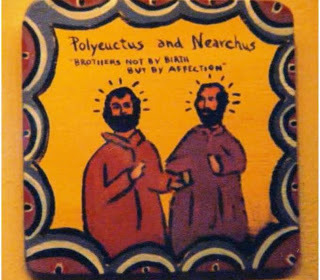
Polyeuctus and Nearchus by Jim Ru
Artist Jim Ru was also inspired to paint Polyeuct and Nearchus. His version was displayed in his show “Transcendent Faith: Gay, Lesbian and Transgendered Saints” in Bisbee Arizona in the 1990s.
O’Neill reports that French writer Robert Dartois recently took the story of Polyeuct and Nearchus from “Passionate Holiness” and turned it into a libretto, which was then set by the Swiss composer Thierry Chatelain as the oratorio “Polyeucte et Nearchus.”
There are many variations in the spellings of their names, such as Polyeuctus, Polyeuctes, Polyeuktos and Nearchos and Nearch. Polyeuct’s feast day is Feb.13 in the Catholic calendar, but falls on Jan. 9 in the Eastern Orthodox tradition and Jan. 7 in ancient Armenian calendars. The feast day for Nearchus is April 22.
___
Related links:
Saints Polyeuct and Nearchos, 3rd Century Lovers and Martyrs (Queer Saints and Martyrs -- And Others)
Homosexuality and Tradition: Polyeuct and Nearchus (Pharsea's World)
___
This post is part of the GLBT Saints series at the Jesus in Love Blog. Saints and holy people of special interest to gay, lesbian, bisexual and transgender (GLBT) people and our allies are covered on appropriate dates throughout the year.
Copyright © Kittredge Cherry. All rights reserved.
http://www.jesusinlove.blogspot.com/
Jesus in Love Blog on LGBT spirituality and the arts
___
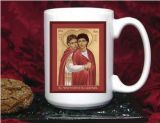
Icons of Polyeuct and Nearchus and many others are available on cards, plaques, T-shirts, mugs, candles, mugs, and more at Trinity Stores

___
Published on February 12, 2013 09:58
February 9, 2013
Top 10 LGBT spiritual arts stories of 2012 named
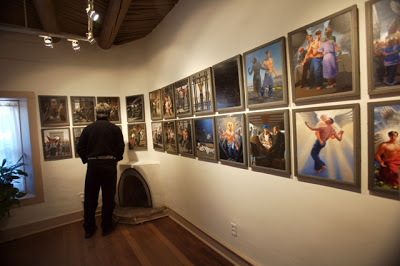
“The Passion of Christ: A Gay Vision” by Douglas Blanchard, at JHS Gallery in Taos, NM (Photo by Dorie Hagler)
A gay vision of Christ’s Passion was the top LGBT spiritual arts story for 2012, the Jesus in Love Blog announced today.
In second place was a cartoon for marriage equality showing Jesus in bed with rock star Freddie Mercury.
The top 10 LGBT spiritual arts stories of the year were named today by Kittredge Cherry, founder of Jesus in Love. The ratings are based on pageviews reported by Google Analytics.
The blog’s most popular post of the year was an introduction to “The Passion of Christ: A Gay Vision,” a series of 24 paintings by Douglas Blanchard with reflections by Kittredge Cherry. The paintings present Jesus as a contemporary gay man in a modern city.
“The gay Passion series was most popular story of 2012, but religious cartoons and queer historical research were also big crowd pleasers,” Cherry said. “Marriage equality was a recurring theme that ran through several of the Top 10 stories this year. LGBT saints and queer Bible interpretation continued to be important to readers of the Jesus in Love Blog.”
Here is a list of the year’s top 10 stories. Click the headlines to see the original posts at the Jesus in Love Blog.
1. Gay Passion of Christ series
All 24 paintings in Douglas Blanchard’s epic masterpiece “The Passion of Christ: A Gay Vision” were posted with new commentary by Kittredge Cherry for Holy Week last year. It covers the events of Palm Sunday, the Last Supper, and his arrest, trial, crucifixion and resurrection. Blanchard’s images show Jesus being jeered by fundamentalists, tortured by Marine look-alikes and rising again to enjoy homoerotic moments with God and friends. He faces forms of rejection that feel familiar to contemporary LGBT people.
Here is a list of individual gay Passion posts in order of popularity. All of these would have made this year’s top 10 list, but they are combined here to prevent the gay Passion from dominating the whole list:
Day 5: Jesus Before the Soldiers; Jesus is Beaten
Day 1: Jesus Enters the City on Palm Sunday
Day 6: Jesus goes to his execution, is nailed to the cross, and dies
Day 2: Jesus drives out the money changers and preaches in the Temple
Blanchard, a gay painter based in New York, and Cherry, a lesbian minister and art historian based in Los Angeles, plan to run an updated version of the series on the Jesus in Love Blog for Holy Week this year and later turn it into a book. More info

“Marriage Made in Heaven”
by Mr. Fish
2. Jesus and Freddie Mercury: Marriage Made in Heaven cartoon supports equality and other religious political cartoons
A gay Jesus cuddles in bed with rock star Freddie Mercury in “Marriage Made in Heaven” by cartoonist Mr. Fish of ClownCrack.com, also known as Dwayne Booth. He created the image to support marriage equality. After a vote banning same-sex marriage, Mr. Fish decided to expose the hypocrisy of anti-gay Christians indirectly by showing Jesus in bed with a gay icon. More info
Two other cartoons on religion and LGBT rights were also hugely popular at the Jesus in Love Blog in 2012:
Cartoon shows Pope mad at nuns and Jesus for not condemning homosexuality
Cartoon: Jesus saves LGBT kids from jaws of clergy hat
3. Saints Sergius and Bacchus: Male couple martyred in ancient Rome
Sergius and Bacchus were third-century Roman soldiers, Christian martyrs and gay men who loved each other. Their story is told here in words and art, including historical works and contemporary art. The couple was openly gay, but secretly Christian -- the opposite of today’s closeted Christians. The close bond between Sergius and Bacchus has been emphasized since the earliest accounts, and recent scholarship has revealed their homosexuality. More info
4. Gay centurion: Jesus heals a soldier’s boyfriend in the Bible
Jesus praised a gay soldier as a role model of faith and healed his male lover in the gospels, according to many Bible experts. Both Matthew 8:5-13 and Luke 7:1-10 tell how a Roman centurion asked Jesus to heal the young man referred to in Greek as his “pais.” The word was commonly used for the younger partner in a same-sex relationship. It is usually translated as boy, servant or slave. In recent years progressive Bible scholars have concluded that the centurion was in a homosexual relationship with the “slave who was dear to him” in the gospel story. More info
5. Jemima Wilkinson: Queer preacher reborn in 1776 as “Publick Universal Friend”
Jemima Wilkinson (1752-1819) was a queer American preacher who woke from a near-death experience in 1776 believing she was neither male nor female. She changed her name to the “Publick Universal Friend,” fought for gender equality and founded an important religious community. In 1776, the same year that America issued the Declaration of Independence, Wilkinson declared her own independence from gender. Wilkinson is recognized as the first American-born woman to found a religious group, but is also called a “transgender evangelist.” More info
6. Gay Jesus kiss: "Corpus Christi" play behind the scenes
Jesus kisses a man behind the scenes at “Corpus Christi,” a play about a gay Jesus by Terrence McNally, in a new photo. A traditional Christ seems to reach across 2,000 years of history to share a kiss with a 21st-century man in a tie-dyed shirt. Jesus is still carrying his cross, but that can’t stop him from expressing man-to-man love with a gay kiss. More info
7. Artist Tony De Carlo paints gay saints, Adam and Steve, and marriage equality art
Artist Tony De Carlo affirms the holiness of gay love with colorful, festive paintings of gay saints, Adam and Steve, same-sex marriage and much more -- all with a zesty Latino flavor. Gay saints in his art include the martyred male couple Sergius and Bacchus and a series on Sebastian, the protector against plague. De Carlo began his ongoing Sebastian series in response to the AIDS crisis. De Carlo has done more than 20 paintings of Adam and Steve as the original gay couple. More info
8. Ash Wednesday: A day to recall queers executed for sodomy
Ash Wednesday is an appropriate time to reflect on the sins of the church and state against queer people, including the burning of “sodomites” and execution of thousands for homosexuality over the past 1,000 years. This article uses historical images and research to remember and honor all those killed for homosexuality in church- or state-sanctioned executions. In 2013 Ash Wednesday will be Feb. 13. More info
9. Joan of Arc: Cross-dressing warrior-saint
Joan of Arc was a tough cross-dressing teenage warrior who led the medieval French army to victory when she was 17. She is a queer icon, girl-power hero and patron saint of France. Smart and courageous, Joan of Arc (c. 1412-1431) had visions of saints and angels who told her to cut her hair, put on men’s clothes and go to war. At age 18 she helped crown a king and at 19 she was killed by the church that later made her a saint. She died for her God-given right to wear men’s clothing, the crime for which she was executed. More info
10. Francis of Assisi’s queer side revealed by historical evidence
Historical records reveal a queer side to Saint Francis of Assisi, one of the most beloved religious figures of all time. The 13th-century friar is celebrated for loving animals, hugging lepers, and praying for peace, but few know about his love for another man and his gender nonconformity. Research by Franciscan scholar Kevin Elphick shows that when Francis was a young man, he had an unnamed male companion whom he dearly loved. Other friars called Francis as “Mother” and “Lady Poverty.” Francis allowed a widow to enter the male-only cloister, naming her “Brother Jacoba.” More info
__
Related links:
2011’s top 10 LGBT spiritual arts stories
2010’s top 7 LGBT spiritual arts stories
2009’s top 7 GLBT spiritual arts stories
2008’s top 5 queer-spirit arts stories
Copyright © Kittredge Cherry. All rights reserved.
http://www.jesusinlove.blogspot.com/
Jesus in Love Blog on LGBT spirituality and the arts
Published on February 09, 2013 11:11
February 1, 2013
Brigid and Darlughdach: Celtic saint loved her female soulmate
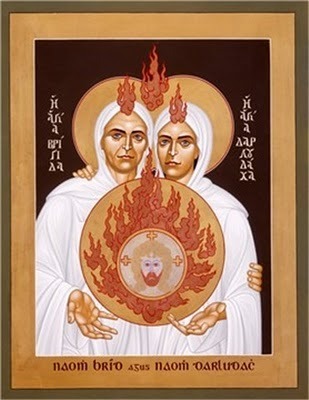
Saints Brigid and Darlughdach of Kildare
By Brother Robert Lentz, OFM. © 1999
trinitystores.com
Saint Brigid and her soulmate Darlughdach were sixth-century Irish nuns who brought art, education and spirituality to early medieval Ireland. Brigid (c.451-525) shares her name and feast day (Feb. 1) with a Celtic goddess -- and she may have been the last high priestess of the goddess Brigid.
Raised by Druids, Brigid seems to have made a smooth transition from being a pagan priestess to a Christian abbess. Today she is Ireland’s most famous female saint. Her name is also spelled Bridget. Legend says that when she made her final vows as a nun, the bishop in charge was so overcome by the Holy Spirit that he administered the rite for ordaining a (male) bishop instead.
A younger nun named Darlughdach served as Brigid’s ambassador and her “anam cara” or soul friend. The two women were so close that they slept in the same bed. Like many Celtic saints, Brigid believed that each person needs a soul friend to discover together that God speaks most powerfully in the seemingly mundane details of shared daily life. The love between these two women speaks to today’s lesbians and their allies. Some say that Brigid and Darlughdach are lesbian saints.
Brigid started convents all over Ireland and became the abbess of the “double monastery” (housing both men and women) at Kildare. Built on land that was previously sacred to her divine namesake, the monastery included an art school for creating illuminated manuscripts.
After turning 70, Brigid warned Darlughdach that she expected to die soon. Her younger soulmate begged to die at the same time. Brigid wanted her to live another year so she could succeed her as abbess. Brigid died of natural causes on Feb. 1, 525. The bond between the women was so close that Darlughdach followed her soulmate in death exactly one year later on Feb. 1, 526.
Both Christians and pagans celebrate St. Brigid’s Day on Feb. 1. It is also known as Imbolc, a spring festival when the goddess Brigid returns as the bride of spring in a role similar to the Greek Persephone. People still celebrate her day by weaving twigs into a square “Brigid’s Cross,” an ancient solar symbol traditionally made to welcome spring.
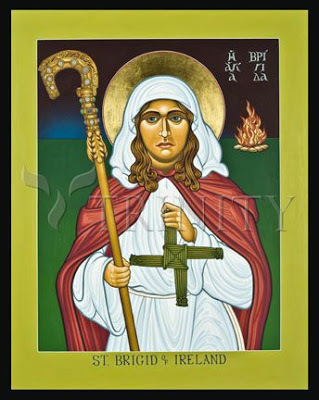
“St. Brigid of Ireland” by Lewis Williams, SFO, trinitystores.com
Brigid’s main symbol was fire, representing wisdom, poetry, healing and metallurgy. The nuns at the Kildare monastery kept a perpetual fire burning in Brigid’s memory for more than a thousand years -- until 1540 when it was extinguished in Henry VIII’s Dissolution of the Monasteries.
The Order of St. Brigid was reestablished in 1807. Two Brigidine sisters returned to Kildare and relit the fire in the market square for the first time in more than 400 years on Feb. 1, 1993. The perpetual flame is now kept at the Solas Bhride (Brigid’s Light) Celtic Spirituality Center that they founded there. In addition, anyone may sign up to tend St. Brigid’s flame in their own homes through the Ord Brighideach Order of Flame Keepers.
Brigid and Darlughdach are shown with their arms around each other in the above icon by Brother Robert Lentz. He is a Franciscan friar and world-class iconographer known for his progressive icons. The two women are dressed in the white gowns worn by Druid priestesses and Celtic nuns. Flames burn above them and on the mandala of Christ that they carry. It is one of 40 icons featured in his book Christ in the Margins
 .
.The icon was commissioned by the Living Circle, a Chicago-based interfaith spirituality center for the gay, lesbian, bisexual and transgender (GLBT) community and their friends. Four Living Circle members took the original icon to Kildare with them in 2000 for the flame-lighting ceremony at the recently excavated site of Brigid’s ancient fire temple.
Dennis O’Neill, the priest who founded the Living Circle, includes the icon and an excellent biography of Brigid and Darlughdach in his book “Passionate Holiness: Marginalized Christian Devotions for Distinctive People
 .”
.” Brigid’s spirit of fun and hospitality is expressed in her reputation for loving beer. She made beer for the poor every Easter. In a well known poem attributed to Brigid, she envisioned heaven as a great lake of beer. Here are some of the words to St. Brigid’s Prayer, as translated and performed by Irish singer Noirin Ni Riain:
I’d sit with the men, the women of God
There by the lake of beer
We’d be drinking good health forever
And every drop would be a prayer.
Riain also sings a heavenly Ode To Bridget on the video below and on her Celtic Soul album.
___
Related links:
February Ritual: Celebrating Brigit, Goddess of Healing, Holy Saint by Diann Neu (WATER)
Santa Brigid y Darlughdach: Irlandés santo amaba a su alma amiga (Santos Queer)
_________
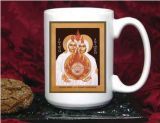
Icons of Brigid and Darlughdach and many others are available on cards, plaques, T-shirts, mugs, candles, mugs, and more at Trinity Stores

_______
This post is part of the GLBT Saints series at the Jesus in Love Blog. Saints and holy people of special interest to gay, lesbian, bisexual and transgender (GLBT) people and our allies are covered on appropriate dates throughout the year.
Copyright © Kittredge Cherry. All rights reserved.
http://www.jesusinlove.blogspot.com/
Jesus in Love Blog on LGBT spirituality and the arts
Published on February 01, 2013 09:21
January 27, 2013
Holocaust Remembrance with new pink triangle art
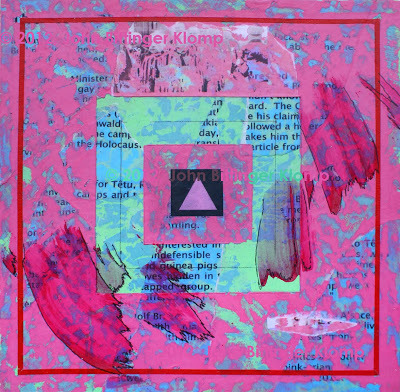 “Pink Triangle” by John Bittinger Klomp, 2012
“Pink Triangle” by John Bittinger Klomp, 2012International Holocaust Remembrance Day honors the victims of the Nazi era, including the estimated 5,000 to 60,000 sent to concentration camps for homosexuality. The United Nations set the date as Jan. 27 -- the anniversary of the liberation of the Auschwitz-Birkenau camp.
Nazis used the pink triangle to identify prisoners sent to concentration camps for homosexuality. Originally intended as a badge of shame, the pink triangle has become a symbol of pride for the LGBT rights movement.
A new painting on the theme is “Pink Triangle” by John Bittinger Klomp, a gay artist based in Florida.
“The Pink Triangle was part of the system of triangles used by the Nazis during World War II to denote various peoples they deemed undesirable, and included Jews, Jehovah’s Witnesses and homosexuals,” Klomp said. The painting is part of his “Gay Dictionary Series” on words and symbols related to being gay.
Established by the UN in 2005, International Holocaust Remembrance Day recalls the state-sponsored extermination of 6 million Jews and 11 million others deemed inferior by the Nazis, including 2.5 million Poles and other Slavic peoples, Soviet prisoners of war, Gypsies and others not of the "Aryan race," the mentally ill, the disabled, LGBT people, and religious dissidents such as Jehovah's Witnesses and Catholics. Holocaust Remembrance Day aims to help prevent future genocides.
The pink triangle appears in a variety of monuments that have been built around the world to commemorate LBGT victims of the Nazi regime. Since 1984, more than 20 gay Holocaust memorials have been established in places ranging from San Francisco to Sydney, from Germany to Uruguay. Some are in the actual concentration camp sites, such as the plaque for gay victims in Dachau pictured below.
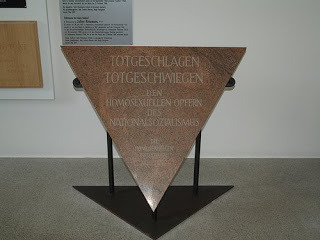 Plaque for gay victims at Dachau concentration camp by nilexuk
Plaque for gay victims at Dachau concentration camp by nilexukTo see powerful photos of all the queer Holocaust memorials and read the stories behind them, visit:
http://andrejkoymasky.com/mem/holocaust/ho08.html
The logo for the Jesus in Love Blog also shows the face of Jesus in a pink triangle. He joins queer people in transforming suffering into power.
Some lesbians claim the black triangle as their symbol. The Nazis imposed the black triangle on people who were sent to concentration camps for being “anti-social.”
One of those who wore the pink triangle was an anonymous 60-year-old gay priest, brutally beaten to death because he refused to stop praying at the concentration camp in Sachsenhausen, Germany. Eyewitness Heinz Heger reported that the murder was so brutal that “I felt I was witnessing the crucifixion of Christ in modern guise.”
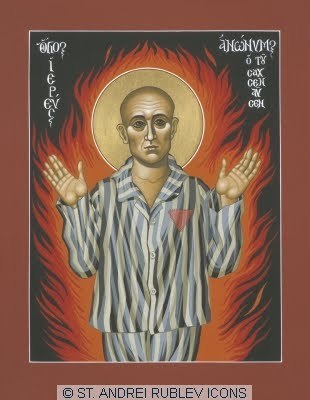 Holy Priest Anonymous one of Sachsenhausen By William Hart McNichols ©www.fatherbill.org
Holy Priest Anonymous one of Sachsenhausen By William Hart McNichols ©www.fatherbill.orgThe priest is honored in the icon above, “Holy Priest Anonymous One of Sachsenhausen.” It was painted by Father William Hart McNichols, a New Mexico artist and Catholic priest who was rebuked by church leaders for making LGBT-affirming icons of unapproved saints. His Anonymous Priest of Sachsenhausen icon appears in his book “The Bride: Images of the Church
 ,” which he co-authored with peace activist Daniel Berrigan.
,” which he co-authored with peace activist Daniel Berrigan. Here is the beginning of his tragic story, as told by Heger in his book The Men With the Pink Triangle
 .
.Toward the end of February, 1940, a priest arrived in our block, a man some 60 years of age, tall and with distinguished features. We later discovered that he came from Sudetenland, from an aristocratic German family.
He found the torment of the arrival procedure especially trying, particularly the long wait naked and barefoot outside the block. When his tonsure was discovered after the shower, the SS corporal in charge took up a razor and said "I'll go to work on this one myself, and extend his tonsure a bit." And he saved the priest's head with the razor, taking little trouble to avoid cutting the scalp. quite the contrary.
The priest returned to the day-room of our lock with his head cut open and blood streaming down. His face was ashen and his eyes stared uncomprehendingly into the distance. He sat down on a bench, folded his hands in his lap and said softly, more to himself than to anyone else: "And yet man is good, he is a creature of God!"
The book goes on to recount in heartbreaking detail how the Nazis tortured the priest, hurling anti-gay slurs and beating him to death. More excerpts are available at the Queering the Church Blog in a post titled The Priest With the Pink Triangle.
In recent years new memoirs of gay Holocaust survivors have been published and queer theory has brought new understanding of the Gay Holocaust as not just atrocities, but also a system of social control. New books include:
I, Pierre Seel, Deported Homosexual: A Memoir of Nazi Terror
 by Pierre Seel (2011)
by Pierre Seel (2011)Lost Intimacies: Rethinking Homosexuality under National Socialism
 by William J. Spurlin (2008)
by William J. Spurlin (2008)An Underground Life: Memoirs of a Gay Jew in Nazi Berlin
 by Gad Beck (2000)
by Gad Beck (2000)The Pink Triangle: The Nazi War Against Homosexuals
 by Richard Plant (1988) -- first comprehensive book on the subject
by Richard Plant (1988) -- first comprehensive book on the subjectInternational Holocaust Remembrance Day is observed here with the prayer “We All Wear the Triangle” by Steve Carson. It appears in the book “Equal Rites: Lesbian and Gay Worship, Ceremonies, and Celebrations
 .” Carson was ordained by Metropolitan Community Churches and served congregations in New York, Boston and San Francisco.
.” Carson was ordained by Metropolitan Community Churches and served congregations in New York, Boston and San Francisco.___
One: We are in many ways a culture without memory. The Holocaust, a series of events that occurred just over a generation ago, changed the world forever. Yet by some the Holocaust is forgotten, or seen as irrelevant, or even viewed as something that never happened.
All: As people of faith, we refuse to forget. We refuse to participate in the erasing of history. As a community of faith, we decide to remember, as we hear the historical record from Europe a generation ago and reflect upon events in our own time. We dare to listen to the voices of the past, even as they echo today.
One: In this moment, we are all Jews wearing the yellow Star of David.
All: We are all homosexuals wearing the pink triangle.
One: We are all political activists wearing the red triangle.
All: We are all criminals wearing the green triangle.
One: We are all antisocials wearing the black triangle.
All: We are all Jehovah’s Witnesses wearing the purple triangle.
One: We are all emigrants wearing the blue triangle.
All: We are all gypsies wearing the brown triangle.
One: We are all undesirable, all extendable by the state.
…Leader: To God of both memory and hope, we pledge ourselves to be a people of resistance to the powers of death wherever they may appear, to honor the living and the dead, and to make with them our promise: Never again!
___
Related link:
Persecution of Homosexuals in Nazi Germany and the Holocaust (Wikipedia)
_________
This post is part of the GLBT Saints series at the Jesus in Love Blog. Saints, martyrs, heroes and holy people of special interest to gay, lesbian, bisexual and transgender (GLBT) people and our allies are covered on appropriate dates throughout the year.
Published on January 27, 2013 12:11
January 26, 2013
David Kato: Ugandan LGBT rights activist (1964-2011)
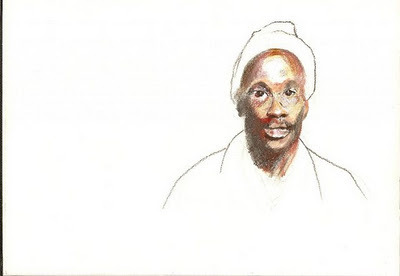
“David Kato” by Rod Byatt
David Kato, Ugandan LGBT rights activist, is considered a father of Uganda’s gay rights movement. He was beaten to death two years ago today (Jan. 26) in a case that some blame on anti-gay religious rhetoric.
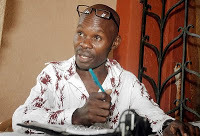
David Kato
American evangelicals helped stir up the hostility that led to Kato’s death because they promoted a law imposing the death penalty for homosexuality. Shortly before his murder Kato won a lawsuit against a Ugandan magazine for identifying him as gay and calling for his execution.
The law never passed and Kato’s murderer was sentenced to 30 years in prison. However, the anti-gay motive for the murder was covered up in the trial.
Australian artist Rod Byatt drew the portrait of David Kato above. The stark, unfinished quality of the portrait conveys the sense of a life cut short. Byatt posted it on his blog **gasp!** (Gay Artists’ Sketchbook Project) with a reflection that begins, “We grieve over the loss of David Kato. We know that being gay is anathema to Family, Church and State, and increasingly The Media...” Byatt is part of the Urban Sketching movement that seeks to link personal identity to broader social issues.
A documentary about Kato, “Call Me Kuchu,” will premiered in 2012 at the Berlin Film Festival. Watch the trailer for the video below. "Kuchu" is the term used in Uganda for LGBT people.
Call Me Kuchu - Trailer from Call Me Kuchu on Vimeo.
Below is a news video about Kato from “The Rachel Maddow Show.” It includes scenes from David’s funeral, where Ugandan clergy speak both for and against LGBT rights, and David’s own voice in an NPR interview about homosexuality in Uganda.
On the anniversary of his murder, may those who honor David Kato’s legacy continue to work for justice and equality for all. May he find peace with all the other LGBT martyrs and saints who have gone before.
___
Related links:
Activists, Filmmakers Mark First Anniversary of David Kato Murder (Towelroad)
Portrait of David Kato by Random Salmon
They will say we are not here (New York Times, Jan. 25, 2012)
Ugandan Activists Commemorate Anniversary of David Kato's Death (Advocate)
David Kato at Wikipedia
In Uganda, a “Fearless Voice” for Gay Rights is Brutally Silenced (Wild Reed Blog)
David Kato: A new Ugandan martyr (Queer Saints and Martyrs - And Others)
Martyrs of Uganda (Walking with Integrity Blog)
The Silence of the Wolves (Counterlight's Peculiars Blog)
Copyright © Kittredge Cherry. All rights reserved.
http://www.jesusinlove.blogspot.com/
Jesus in Love Blog on LGBT spirituality and the arts
Published on January 26, 2013 09:06
January 23, 2013
First openly LGBT clergy ever helps lead Inaugural Prayer Service
A lesbian minister, Nancy Wilson of Metropolitan Community Churches, became the first openly gay or lesbian clergy member in history to participate as a worship leader a Presidential Inaugural Prayer Service.
She read the scripture at President Obama’s Inaugural Prayer Service yesterday morning (Jan. 22) at the National Cathedral in Washington.
You can see her reading the Bible passage (Isaiah 55:6-11) there on video at this link:
http://www.youtube.com/watch?v=rIrhAh-ApYg
I worked closely with Nancy in the 1990s when I was MCC’s National Ecumenical Officer and she was Chief Ecumenical Officer. Since then she went on to become moderator of the whole Metropolitan Community Churches denomination, which was founded in 1968 as a LGBT-affirming church and now has ministries in 40 countries. Nancy was part of the first LGBT delegation to meet with a sitting president in 1979. Almost 35 years later she is serving on President Obama's Advisory Council on Faith-Based and Neighborhood Partnerships.
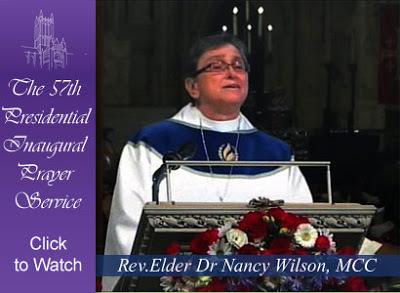
Rev. Nancy Wilson at President Obama’s Inaugural Prayer Service (mccchurch.org)
Nancy read a scripture that includes one of my favorite lines: "My word... will not return to me empty; but it will accomplish that which I have purposed, and prosper in that for which I sent it."
How often I turned to that scripture in the early days of my LGBT ministry! It helped me through the emptiness of the AIDS crisis and the rejections that Nancy and I faced in trying to do "dialogue on homosexuality" at the World Council of Churches and National Council of Churches. It is amazing to see that the seeds we planted are bearing fruit now. God's purpose is being accomplished, although the journey is far from over.
Nancy stood for many queer people when read the Bible at the Inaugural Prayer service. Before the event, she wrote about what is means in a blog post for Believe Out Loud: “When I stand in the presence of President Barack Obama and Vice President Joseph Biden to read the Hebrew Bible under the soaring arches of the National Cathedral on Tuesday, I will be exalting. This exaltation is not for myself but for the millions of lesbian, gay, bisexual and transgender (LGBT) people who have longed for a safe place to call home,” she wrote.
The Inaugural Prayer Service was the final event on the inauguration schedule. The inclusion of an openly lesbian minister was a suitable ending for an inauguration with many breakthroughs for LGBT people. No president had ever even mentioned LGBT people before in an Inauguration speech, but Obama set a new precedent with a strong affirmation of LGBT equality:
We, the people, declare today that the most evident of truths – that all of us are created equal – is the star that guides us still; just as it guided our forebears through Seneca Falls, and Selma, and Stonewall; just as it guided all those men and women, sung and unsung, who left footprints along this great Mall, to hear a preacher say that we cannot walk alone; to hear a King proclaim that our individual freedom is inextricably bound to the freedom of every soul on Earth.
It is now our generation’s task to carry on what those pioneers began. For our journey is not complete until our wives, our mothers, and daughters can earn a living equal to their efforts. Our journey is not complete until our gay brothers and sisters are treated like anyone else under the law – for if we are truly created equal, then surely the love we commit to one another must be equal as well. Our journey is not complete until… click here for full text.
___
Related links:
Inaugural Prayer Service Includes First Out Gay Clergy Member (Advocate)
A Lesbian, a Bible and an Inauguration Service: In Search of Safe Homes by Nancy Wilson (Believe Out Loud)
Copyright © Kittredge Cherry. All rights reserved.
http://www.jesusinlove.blogspot.com/
Jesus in Love Blog on LGBT spirituality and the arts
Published on January 23, 2013 13:42
January 20, 2013
Saint Sebastian: History’s first gay icon
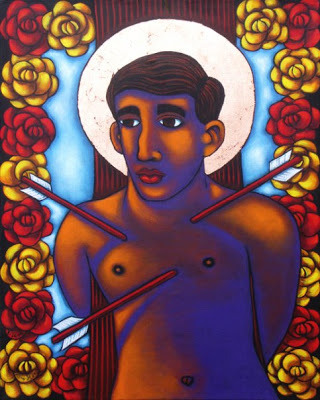
“Homage to Sebastian” by Tony De Carlo
Saint Sebastian has been called history’s first gay icon and the patron saint of homosexuals. His feast day is today (Jan. 20).
Sebastian was an early Christian martyr killed in 288 on orders from the Roman emperor Diocletian. He is the subject of countless artworks that show him being shot with arrows. Little is known about his love life, so his long-standing popularity with gay men is mostly based on the way he looks .
Starting in the Renaissance, Sebastian has been painted many times as a near-naked youth writing in a mixture of pleasure and pain. The homoeroticism is obvious.
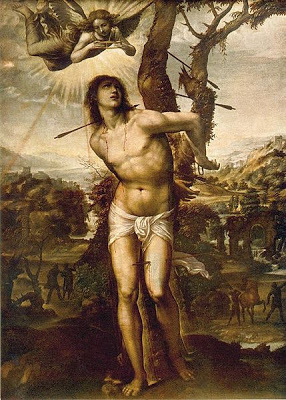
“Saint Sebastian”by Il Sodoma, 1525 (Wikimedia Commons)
Other blogs have already compiled the St. Sebastian masterpieces from art history, so I will simply post one example and refer readers to the best online collection of Sebastian art that I have found:
Saint Sebastian: The Homoerotic Patron of Gay Men (Artwork I Love Blog)
Saint Sebastian is a favorite subject of contemporary gay artist Tony De Carlo, whose work is at the top of this post. He began his ongoing Sebastian series in the 1980s in response to the AIDS crisis. It has grown to more than 40 pictures.
“I chose him because he was known as the Patron Protector Saint Against the Plague, as the Plague was sweeping Europe,” De Carlo said in an interview with the Jesus in Love Blog. “It wasn't until the year 2001 when I went into a Catholic store in New Mexico, picked up a pewter statue of Saint Sebastian, and saw a label on the bottom that said ‘Patron Saint of Homosexuals.’”
The historical Sebastian actually survived the arrow attack and was nursed back to health by Saint Irene of Rome, only to be “martyred twice” when the emperor executed him later.
Sebastian is also referenced frequently in the gay literary world. For example playwright Tennessee Williams named his martyred gay character Sebastian in “Suddenly, Last Summer,” and Oscar Wilde used Sebastian as his own alias after his release from prison.
___
Related links:
Subjects of the Visual Arts: St. Sebastian (glbtq.com)
Not Dead Yet: St Sebastian as Role Model (Queering the Church)
St. Sebastian (LGBT Catholic Handbook)
Copyright © Kittredge Cherry. All rights reserved.
http://www.jesusinlove.blogspot.com/
Jesus in Love Blog on LGBT spirituality and the arts
Published on January 20, 2013 11:16
January 17, 2013
Lesbian Virgin Mary poster protested in Croatia
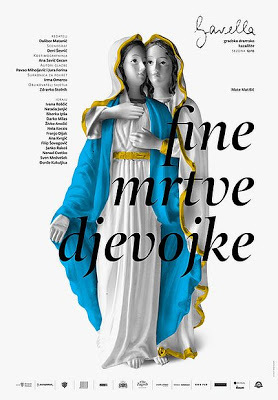
Poster for “Fine Dead Girls” from Gavella Theatre
A poster with a lesbian Virgin Mary was withdrawn in Croatia yesterday after religious and political pressure. It advertised the play “Fine Dead Girls” at the municipal Gavella Theatre in Zagreb.
According to Croatian news reports, the mayor of Zagreb ordered theater director Darko Stazic to remove the poster from all public areas after an unprecedented campaign against it by Catholic and other religious groups. They denounced the poster as blasphemy.
Now the theater director is being criticized for cowardice by some LGBT Croatians advocating freedom of expression.
The controversial poster shows a traditional statue of Mary being embraced from behind by another woman. “Fine Dead Girls” (Fine Mrtve Djevojke) by Dalibor Matanic is about a young lesbian couple who move into a seemingly quiet apartment building in Zagreb. Soon they face hostility from neighbors and family, including a religious fundamentalist father. The theatrical version is based on the award-winning 2002 film of the same title.
As a lesbian Christian, I am upset by the censorship of the lesbian Virgin Mary. The conservatives got rid of the lesbian Virgin Mary posters by demanding their religious rights, but what about my right to see images that affirm me as a lesbian Christian?! I welcome images that show lesbian love as sacred, but they are hard to find.
The Croatian controversy is the most recent of many conflicts over LGBT religious images as freedom of religion clashes with freedom of speech. It is important to support LGBT Christian images because conservatives use religious rhetoric to justify discrimination against queer people.
Similar controversies are covered in my book Art That Dares: Gay Jesus, Woman Christ, and More. I report about the more recent controversies on this blog, including a gay Nativity in Columbia, a queer baby Jesus poster in New Zealand, a gay Jesus exhibit in Spain, “Our Lady” by Latina lesbian artist Alma Lopez, and a crucifix symbolizing the pain of gay men with AIDS by David Wojnarowicz at the Smithsonian.
____
Related links:
Lesbian Virgin Mary posters withdrawn (Croatian Times)
Fine Dead Girls film (Amazon.com)
David Wojnarowicz : Smithsonian censors gay artist when conservatives attack (Jesus in Love)
Alma Lopez: Our Lady and Queer Saints art attacked as blasphemy (Jesus in Love)
Fernando Bayona Gonzalez: Protests end gay Jesus exhibit in Spain (Jesus in Love)
Conservatives attack our lesbian and gay Nativity scenes today! (Jesus in Love)
Copyright © Kittredge Cherry. All rights reserved.
http://www.jesusinlove.blogspot.com/
Jesus in Love Blog on LGBT spirituality and the arts
Published on January 17, 2013 14:03
January 15, 2013
In memory of PFLAG founder Jeanne Manford, who loved her gay son
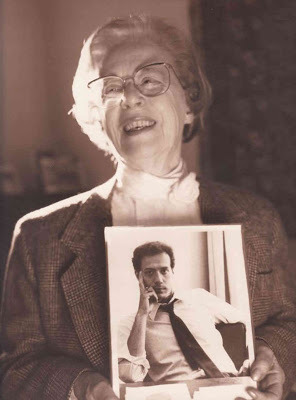
Jeanne Manford in 1993 with a photo of her gay son Morty
In memory of
Jeanne Manford
PFLAG founder
Dec. 4, 1920 - Jan. 8, 2013

I light a memorial candle for Jeanne Manfred, founder of Parents, Families, and Friends of Lesbians and Gays (PFLAG). She died on Jan. 8, 2013, at age 92.
Her son, the late Morty Manford, was beaten during a gay rights protest in April 1972. She responded by writing a letter to the New York Post stating, “I have a homosexual son, and I love him.” A couple months later she and her son marched in New York's Christopher Street Liberation Day Parade. These actions and the support she received led to the founding of PFLAG in 1973.
PFLAG has grown to 350 chapters with 200,000 members, and Jeanne Manford is an inspiration to many. President Obama talked about her in his 2009 speech to the Human Rights Campaign National Dinner in 2009.
Thank you, Jeanne, for your courage and your love! I count you among the LGBT saints for the huge positive impact that you had on queer people and straight allies everywhere.
___
Related links:
Jeanne Manford, 92, Who Stood Up for Her Gay Son, Inspiring Others, Dies (New York Times)
PFLAG Founder Jeanne Manford Dies at 92 (Advocate)
PFLAG.org
Patron saints for straight allies of LGBT people: Adele Starr of PFLAG and others (Jesus in Love)
____
This post is part of the GLBT Saints series by Kittredge Cherry at the Jesus in Love Blog. Saints, martyrs, mystics, heroes, holy people, deities and religious figures of special interest to lesbian, gay, bisexual and transgender (LGBT) and queer people and our allies are covered on appropriate dates throughout the year.
Copyright © Kittredge Cherry. All rights reserved.
http://www.jesusinlove.blogspot.com/
Jesus in Love Blog on LGBT spirituality and the arts
Published on January 15, 2013 12:18
January 12, 2013
Aelred of Rievaulx: Gay saint of friendship
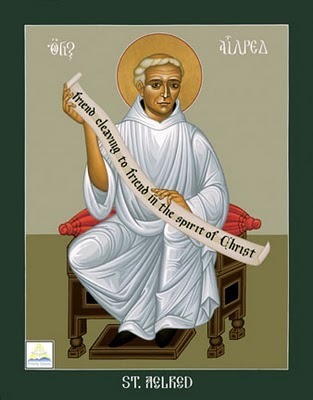 St. Aelred of RievaulxBy Brother Robert Lentz, OFM, www.trinitystores.com
St. Aelred of RievaulxBy Brother Robert Lentz, OFM, www.trinitystores.comAelred (1109-1167) is considered one of the most lovable saints, the patron saint of friendship and also, some say, a gay saint. His feast day is today (Jan. 12).
Aelred was the abbott of the Cistercian abbey of Rievaulx in England. His treatise “On Spiritual Friendship” is still one of the best theological statements on the connection between human love and spiritual love. “God is friendship… He who abides in friendship abides in God, and God in him,” he wrote, paraphrasing 1 John 4:16.
Aelred’s own deep friendships with men are described in Christianity, Social Tolerance, and Homosexuality
 by Yale history professor John Boswell. “There can be little question that Aelred was gay and that his erotic attraction to men was a dominant force in his life,” Boswell wrote.
by Yale history professor John Boswell. “There can be little question that Aelred was gay and that his erotic attraction to men was a dominant force in his life,” Boswell wrote.Boswell’s account inspired the members of the LGBT Episcopal group Integrity to name Aelred as their patron saint. Click here for the full story on how they won recognition for their gay saint.
Aelred certainly advocated chastity, but his passions are clear in his writing. He describes friendship with eloquence in this often-quoted passage from his treatise On Spiritual Friendship
 :
:“It is no small consolation in this life to have someone who can unite with you in an intimate affection and the embrace of a holy love, someone in whom your spirit can rest, to whom you can pour out your soul, to whose pleasant exchanges, as to soothing songs, you can fly in sorrow... with whose spiritual kisses, as with remedial salves, you may draw out all the weariness of your restless anxieties. A man who can shed tears with you in your worries, be happy with you when things go well, search out with you the answers to your problems, whom with the ties of charity you can lead into the depths of your heart; . . . where the sweetness of the Spirit flows between you, where you so join yourself and cleave to him that soul mingles with soul and two become one.”
Aelred supported friendships between monks, comparing them to the love between Jesus and his beloved disciple, and between Jonathan and David in his treatise on spiritual friendship. Louis Crompton reports in Homosexuality and Civilization
 that Aelred allowed the monks at his Yorkshire monastery to express affection by holding hands, a practice discouraged by other abbots.
that Aelred allowed the monks at his Yorkshire monastery to express affection by holding hands, a practice discouraged by other abbots.The icon of Saint Aelred was painted by Robert Lentz, a Franciscan friar and world-class iconographer known for his innovative icons. It includes a banner with Aelred’s words, “Friend cleaving to friend in the spirit of Christ.”
___
Related links:
12th January: St Aelred of Rievaulx, Patron of Same Sex Intimacy (Queer Saints and Martyrs -- and Others)
A St. Aelred Catechism (Walking with Integrity Blog)
St. Aelred of Rievaulx (Pharsea’s World: Homosexuality and Tradition)
Worship resources for Saint Aelred (Integrity USA)
San Elredo de Rievaulx: Santos gay de amistad (Santos Queer)
_________
This post is part of the LGBT Saints series at the Jesus in Love Blog. Saints and holy people of special interest to gay, lesbian, bisexual and transgender (GLBT) people and our allies are covered on appropriate dates throughout the year.
___
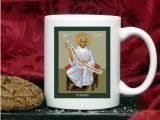 Icons of St. Aelred and many others are available on cards, plaques, T-shirts, mugs, candles, mugs, and more at Trinity Stores
Icons of St. Aelred and many others are available on cards, plaques, T-shirts, mugs, candles, mugs, and more at Trinity Stores
Copyright © Kittredge Cherry. All rights reserved.
http://www.jesusinlove.blogspot.com/
Jesus in Love Blog on LGBT spirituality and the arts
Published on January 12, 2013 00:27
Q Spirit
Q Spirit promotes LGBTQ spirituality, with an emphasis on books, history, saints and the arts.
- Kittredge Cherry's profile
- 9 followers



